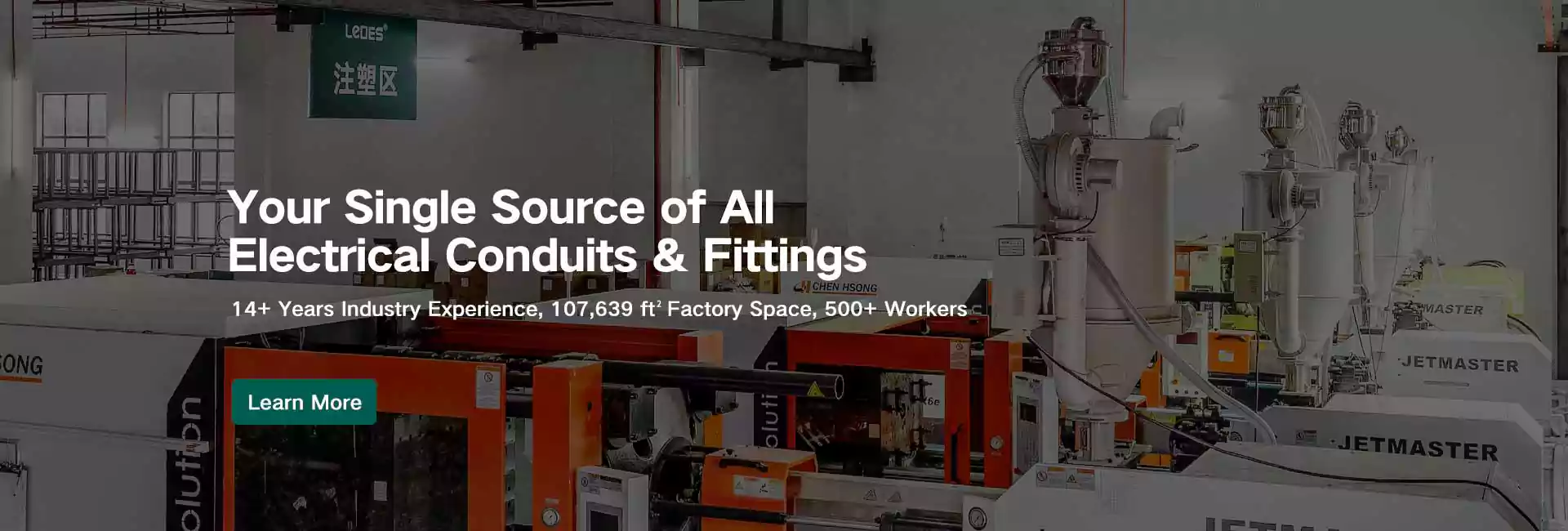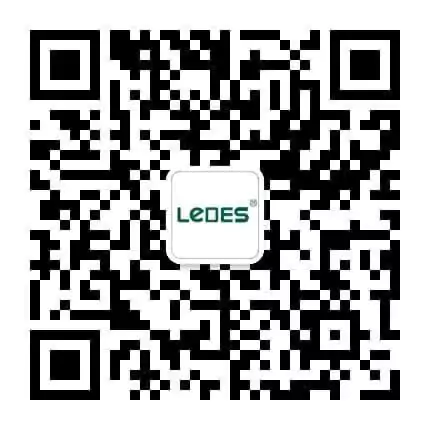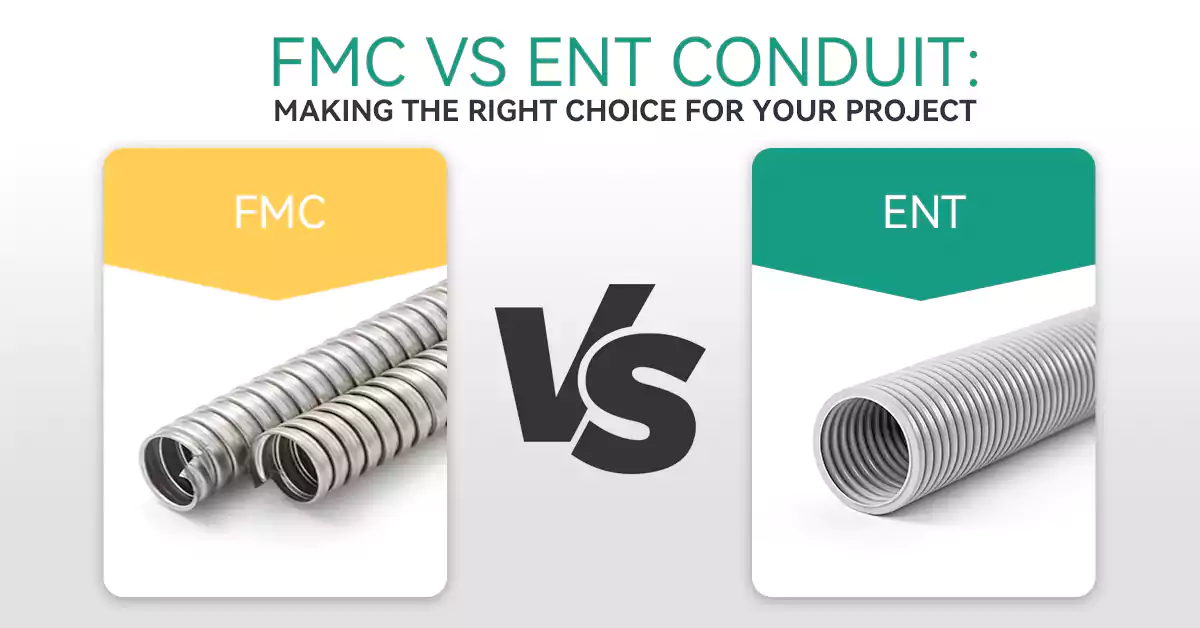
Tabla de contenido
When a project calls for flexible conduit routing, two conduit types consistently stand out as go-to solutions: Flexible Metal Conduit (FMC) and Electrical Nonmetallic Tubing (ENT Conduit). Whether you’re navigating tight spaces, working around obstacles, or designing a system with future accessibility in mind, both FMC conduit and ENT tubing offer the flexibility and protection needed for a safe and efficient electrical installation.
These conduits are widely used across residential, commercial, and light industrial settings where rigid conduit simply isn’t practical. But while they share a degree of flexibility, they differ significantly in terms of material, code requirements, physical durability, and environmental performance.
Why It’s Important to Understand the Difference
Choosing between FMC electrical conduit and ENT conduit isn’t just a matter of preference, it’s a decision that affects safety, compliance, cost, and long-term reliability. FMC, with its durable metal construction, offers excellent mechanical protection and inherent grounding. ENT, on the other hand, is lightweight, easy to install, and ideal for low-impact environments such as interior wall cavities or ceilings.
Understanding the strengths, limitations, and best-use scenarios for flexible metal conduit and electrical nonmetallic tubing ensures you can design and install a system that meets your project’s technical and regulatory requirements while optimizing labor and material costs.
What is FMC Conduit?
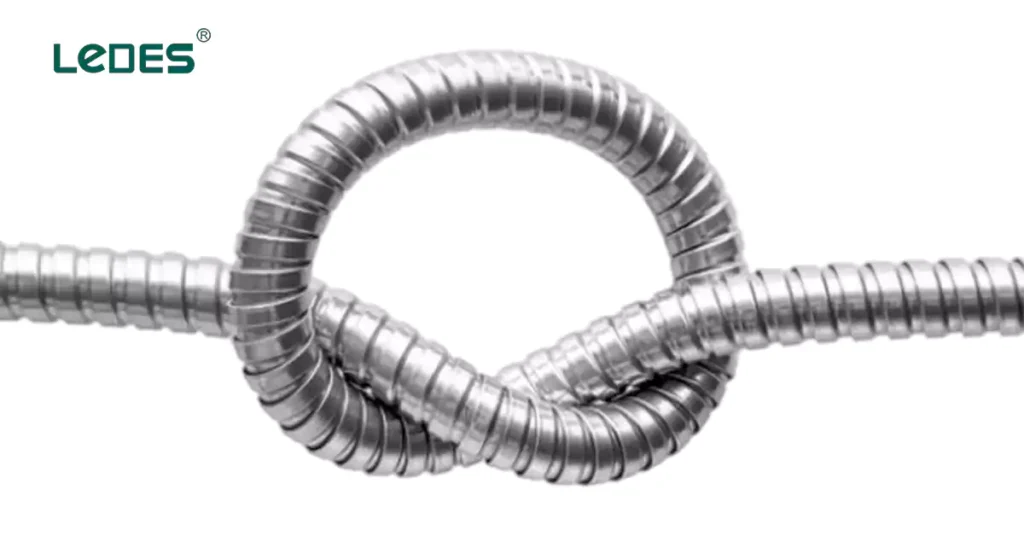
Flexible Metal Conduit (FMC), also known informally as Greenfield or simply flex, is a type of metallic conduit designed for flexible routing of electrical wiring. Unlike rigid conduit systems that require elbows and extensive cutting, FMC electrical conduit offers a bendable, adaptable pathway that simplifies installation in tight, irregular, or vibration-prone areas.
Definition and Construction
FMC is constructed by helically coiling a self-interlocked, ribbed strip of metal, usually aluminum or steel, to form a hollow tube. This spiral-shaped construction creates a flexible, yet mechanically protective conduit through which electrical conductors can be pulled. The interior is generally smooth enough to minimize wire abrasion, and the conduit’s form allows it to bend freely without holding a fixed shape, perfect for navigating around obstacles or through confined architectural spaces.
FMC does not maintain a permanent bend, which distinguishes it from some other types of flexible conduit. This characteristic allows it to accommodate system vibrations and shifting structures, making it ideal for installations in equipment connections, ceiling cavities, or retrofitting projects.
Materials Used in FMC
FMC conduit is typically made from:
- Acero galvanizado: Offers high mechanical strength and corrosion resistance, suitable for indoor dry locations.
- Aluminio: Lightweight and corrosion-resistant, often chosen where minimizing weight or magnetic interference is important.
Both materials are fire-resistant and meet key UL standards for mechanical and electrical performance.
Key Features and Advantages of FMC
Flexible Metal Conduit (FMC) is valued for its adaptability and mechanical protection, especially in environments where rigid conduit is too limiting. From commercial buildings to industrial settings and residential retrofits, FMC offers several distinct benefits that make it a preferred choice for certain electrical installations.
1. High Flexibility
One of the most significant advantages of FMC conduit is its ability to bend freely without special tools. Unlike rigid systems that require prefabricated elbows or precise cutting, FMC can be routed easily around structural obstacles, through wall cavities, and into electrical enclosures with minimal effort. This flexibility translates into:
- Faster installations
- Simplified retrofits
- Reduced need for fittings and joints
FMC is particularly useful in areas subject to vibration, such as motor and equipment connections, where rigid conduit would be more prone to fatigue or damage.
2. Mechanical Protection and Durability
Despite its flexible nature, FMC electrical conduit still offers a high level of mechanical protection. Its metallic construction helps guard conductors against:
- Physical impact
- Crushing forces
- Rodents or insects
This makes FMC a smart choice in environments that demand both routing flexibility and a degree of conductor protection, such as mechanical rooms, utility spaces, and commercial ceilings.
3. Fire Resistance and Safety
FMC is made from non-combustible metals like galvanized steel or aluminum, which means it offers fire-resistant properties that many plastic or non-metallic alternatives cannot. This can be a critical factor in high-risk or code-sensitive installations.
Additionally, FMC is suitable for use in systems requiring electromagnetic interference (EMI) shielding, as its metallic body can help reduce EMI transmission, especially in data-sensitive environments.
4. Grounding Capability (Conditional)
Under the National Electrical Code (NEC), FMC can serve as an equipment grounding conductor, but only under certain conditions based on length, size, and circuit amperage. In short runs with appropriate trade sizes, FMC can eliminate the need for a separate grounding wire, saving time and material costs.
However, for longer runs or higher-amperage circuits, a dedicated grounding conductor should still be pulled through the conduit to ensure code compliance and safety.
5 Common Applications of FMC Conduit
Flexible Metal Conduit (FMC) is a versatile solution used across a wide range of electrical installations. Its unique combination of bendability, mechanical protection, and metallic shielding makes it especially suitable for complex layouts, equipment connections, and retrofitting work. Below are the most common applications and real-world scenarios where FMC conduit proves to be the right choice.
1. Equipment Connections
FMC is often the go-to conduit for connecting motors, transformers, HVAC units, and generators. These types of equipment typically produce movement or vibration during operation, which could damage rigid conduit over time. FMC’s ability to flex and absorb motion helps prevent:
Loosening of terminations
Conductor fatigue
Cracking or splitting of conduit
This makes FMC essential in mechanical rooms, industrial plants, and commercial facilities where reliability is critical.
2. Tight or Irregular Installation Spaces
In buildings where space is limited or the structure is irregular, FMC simplifies routing in ways rigid conduit cannot. Its flexible design allows electricians to snake the conduit around obstructions.
This makes FMC ideal for retrofit projects, remodeling, or any installation that must navigate confined or finished spaces without major construction.
3. Commercial and Institutional Buildings
In office buildings, schools, and hospitals, FMC is used for:
Branch circuit wiring
Lighting connections
Feeders for modular partitions
Ceiling grid power delivery
Its code-compliant metallic protection and low-profile flexibility make it practical in these settings, particularly where aesthetics or minimal disruption is required.
4. Temporary Power Systems
In temporary installations such as construction sites or events, FMC can be used for flexible and fast wiring between equipment and panels. Its ease of handling and reusability allow contractors to:
Adjust setups quickly
Minimize material waste
Comply with safety requirements for exposed wiring
5. Data Centers and Communications Rooms
FMC can provide EMI shielding in environments where data integrity is critical. Its metallic body helps contain and block electromagnetic interference, which is essential when installing power lines near sensitive communication or IT equipment.
In summary, FMC conduit offers the flexibility, strength, and code-recognized protection needed in specialized and high-performance electrical systems. Whether for dynamic environments like machine rooms or space-constrained retrofits in office ceilings, FMC delivers practical value across many sectors.
Liquid-tight Flexible Metal Conduit Option
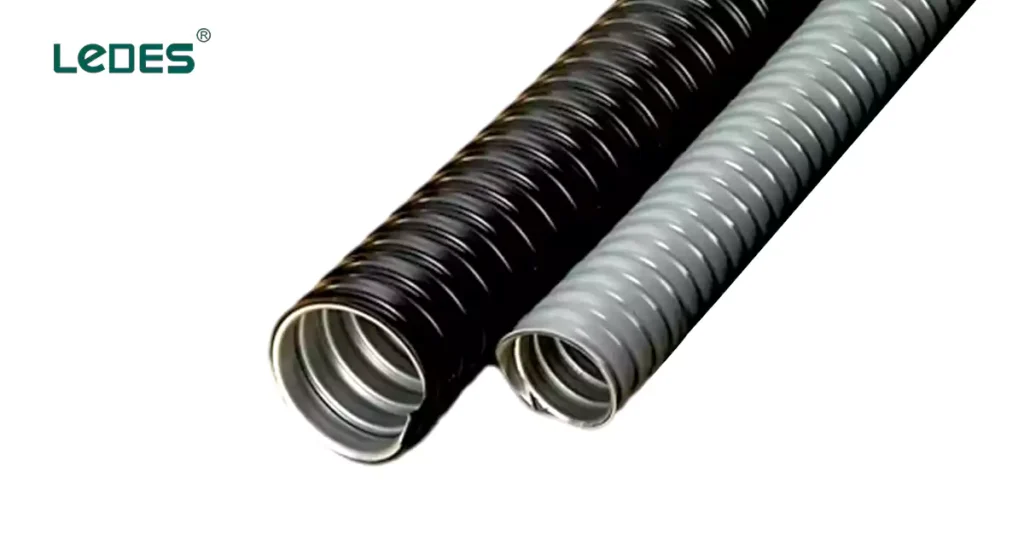
In applications where moisture, oil, or outdoor exposure are concerns, standard Flexible Metal Conduit (FMC) may not be sufficient. That’s where Liquid-tight Flexible Metal Conduit (LFMC) becomes the preferred solution. LFMC builds on the flexibility and strength of traditional FMC but adds an important layer of environmental protection.
What Is LFMC?
Liquid-tight Flexible Metal Conduit (LFMC) is a type of flexible metal conduit that features a protective outer jacket, typically made of PVC (polyvinyl chloride). Inside, it uses the same interlocked helical steel or aluminum core as standard FMC, but the exterior is sealed against moisture, oils, and corrosive agents.
This construction allows LFMC to combine:
- The mechanical protection and grounding capability of metal conduit
- The moisture resistance of a sealed, plastic-coated system
- The flexibility of a coil-type structure
Where Is LFMC Used?
LFMC is especially valuable in wet, damp, or hazardous locations, where standard FMC or ENT tubing would not meet code requirements. Typical applications include:
- Outdoor equipment connections (e.g., air conditioning units, lighting, pumps)
- Car washes, food processing plants, or industrial washdown areas
- Underground stub-ups (when transitioning from buried conduit to surface equipment)
- Marine and shipboard installations
- Commercial rooftops and parking lots
- Oil and gas industry facilities
4 Advantages of LFMC Conduit
LFMC offers several key advantages over standard FMC:
- Watertight and corrosion-resistant: Ideal for wet or corrosive environments
- UV-resistant jacket: Suitable for prolonged outdoor exposure
- Flame-retardant: Adds fire protection where required
- Maintains flexibility: Easy to install in tight or awkward spaces
To ensure safety and compliance, it’s essential to use UL-listed LFMC and approved fittings suited for the environment.
Codes and Standards for FMC Conduit

To ensure safe and compliant electrical installations, Flexible Metal Conduit (FMC) must meet specific standards and regulatory codes in the United States and Canada. These regulations define the permissible applications, construction characteristics, installation rules, and safety requirements for FMC and some for LFMC.
Overview of the Codes and Standards FMC
- Código Eléctrico Nacional (NEC) – Article 348 (FMC)
- Código Eléctrico Canadiense (CEC) – Section 12-1000 to 12-1012 (FMC)
- UL 1 – Flexible Metal Conduit
- CSA C22.2 No.56-17 – Flexible Metal Conduit and Liquid-tight Flexible Metal Conduit
NEC Article 348 – Flexible Metal Conduit (FMC)
The National Electrical Code (NEC) Article 348 is the principal authority in the U.S. governing FMC installations. Here’s a summarized breakdown of its major provisions:
Usos permitidos
FMC can be used in both exposed and hidden (concealed) areas inside buildings. It’s ideal for short runs to lighting fixtures or equipment that may need to be moved or adjusted later.
Usos no permitidos
FMC cannot be installed:
In wet or damp locations
In hazardous or flammable environments (unless specifically permitted)
Embedded in concrete or underground
Where it may be exposed to oil, gasoline, or other damaging substances
In hoistways (elevator shafts), unless exceptions apply
Where subject to physical damage
Size Limitations
The maximum trade size allowed for FMC is 4 inches (metric designator 103).
The smallest size (3/8 inch) is only permitted in specific short-length applications, like motor leads or fixture connections, and generally not over 6 feet long.
Conductor Fill Limits
The number of wires inside the conduit is limited by NEC fill tables to prevent overheating.
There’s a special fill chart for 3/8-inch FMC, depending on wire type and insulation.
Only one equipment grounding conductor is allowed in addition to the current-carrying wires.
Bending Rules
FMC can be bent by hand, but the bending radius must be wide enough to avoid damaging the conduit.
The total amount of bending (in degrees) from box to box cannot exceed 360 degrees.
Supporting and Securing FMC
FMC must be securely fastened:
- Within 12 inches of each box, cabinet, or termination
- At least every 4.5 feet (1.4 meters) along its run
Hay excepciones para lugares donde el soporte no es práctico, como dentro de paredes terminadas o para conexiones de accesorios flexibles.
Requisitos de conexión a tierra y unión
El FMC puede servir como ruta de conexión a tierra, pero sólo si no se necesita flexibilidad después de la instalación.
Si el FMC se utiliza para equipos que se mueven o vibran, se debe instalar un conductor de tierra de equipo separado.
Los puentes de unión y los conductores de puesta a tierra deben seguir las reglas NEC.
Requisitos del Código Eléctrico Canadiense para FMC
Según el Código Eléctrico Canadiense (CEC), el FMC se agrupa con el conducto metálico rígido (RMC), y ambos se rigen por normas específicas (Secciones 12-1000 a 12-1014). Esto es lo que necesita saber al trabajar con FMC en instalaciones canadienses:
Usos
Se puede utilizar FMC en edificios construidos con materiales combustibles o no combustibles.
Se utiliza a menudo en conexiones cortas y flexibles a equipos o accesorios, especialmente cuando se espera algún movimiento o reposicionamiento.
Límites de tamaño mínimo
En general, no se permiten conductos de tamaño comercial menor al 16.
Sin embargo, se permite el tamaño comercial 12 FMC para tramos cortos de hasta 1,5 metros para conectar equipos.
Esto hace que FMC sea ideal para conexiones finales donde se necesita flexibilidad.
Requisitos de soporte y seguridad
- El FMC debe asegurarse a intervalos no mayor de 1,5 metros.
- También debe fijarse a una distancia de 300 mm de cada caja de salida o accesorio.
- Excepciones: No es necesario asegurar el FMC cuando se “pesca” a través de paredes o en tramos cortos (menos de 900 mm) en puntos de conexión que necesitan flexibilidad.
Conductores dentro de FMC
Los cables instalados en FMC deben cumplir con la Regla 12-910, garantizando un aislamiento adecuado, clasificación de temperatura y límites de llenado.
El FMC se considera como una canalización y debe dimensionarse adecuadamente para evitar el sobrecalentamiento de los conductores.
UL 1 - Norma para conductos metálicos flexibles (FMC)
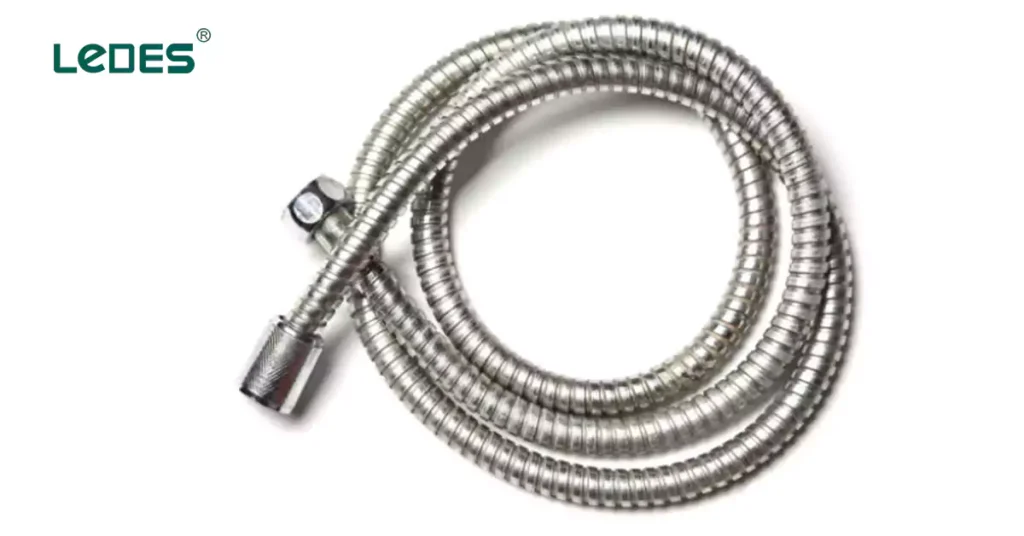
La norma UL 1 describe los requisitos esenciales de construcción y rendimiento para FMC, garantizando la seguridad, flexibilidad y durabilidad en las instalaciones eléctricas. A continuación, se presenta una descripción general simplificada de las áreas clave que abarca la norma.
Construcción y materiales
El FMC está hecho de tiras de acero o aluminio.
Acero: Debe ser de acero al carbono con una resistencia a la tracción mínima de 34 000 psi y libre de óxido o sarro antes de ser recubierto con zinc.
Aluminio: También debe cumplir con una resistencia a la tracción mínima de 34 000 psi y tener un contenido de cobre ≤0,40%.
Calidad de la tira:
La tira debe ser uniforme en ancho y espesor. Los empalmes (si los hay) no deben afectar la resistencia del conducto ni su diámetro interior.
Convoluciones:
El número de circunvoluciones (crestas espirales) debe cumplir requisitos mínimos de flexibilidad y resistencia.
Superficie interior:
La superficie interior debe ser lisa y libre de rebabas o bordes afilados para proteger el cableado durante la instalación.
Dimensiones
Espesor de la tira:
El espesor mínimo se define según el tamaño comercial. Tipos especiales como XRWFMC pueden usar tiras más delgadas si cumplen con todas las pruebas requeridas.
Diámetros interiores y exteriores:
Tanto los diámetros internos como externos deben estar dentro de las tolerancias especificadas por UL para garantizar un ajuste adecuado y seguridad en la aplicación.
Requisitos de desempeño
Para garantizar la durabilidad, seguridad y conformidad de los conductos flexibles de acero y aluminio, se realizan diversas pruebas de rendimiento clave de acuerdo con las normas. Estas incluyen:
Prueba de recubrimiento de zinc
Esto evalúa la calidad del recubrimiento de zinc, tanto en la banda de acero antes del conformado como en el conducto terminado. El recubrimiento debe resistir la deposición de cobre durante la inmersión en una solución de sulfato de cobre, lo que garantiza la protección contra la corrosión y un rendimiento a largo plazo.
Prueba de tensión
El conducto terminado debe soportar una carga de tracción especificada (300 lbf) sin abrirse ni separarse, verificando su resistencia mecánica bajo tensión.
Prueba de flexibilidad
El conducto se dobla alrededor de una superficie cilíndrica de un radio designado para confirmar que mantiene la integridad estructural y no abre ni expone la superficie interna.
Prueba de resistencia al impacto (para tipos de pared reducida)
Esta prueba evalúa la capacidad del conducto para soportar impactos físicos sin fallar, lo cual es fundamental para entornos de instalación exigentes.
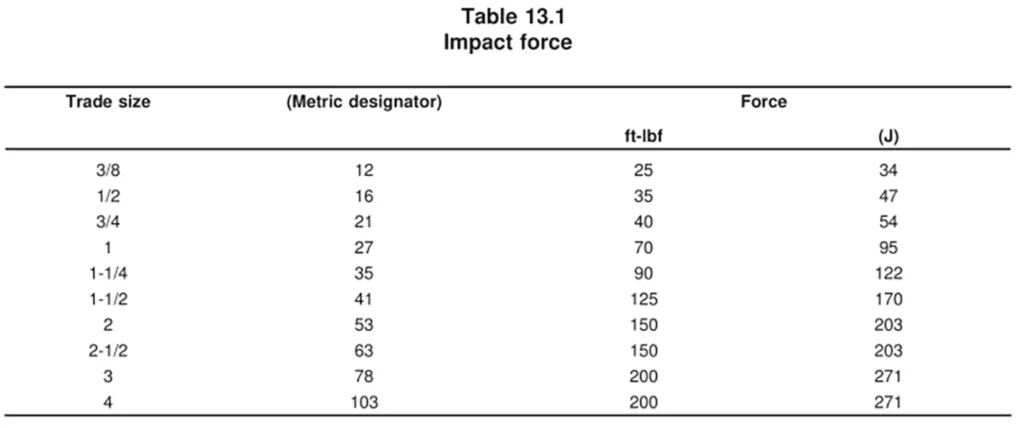
Requisitos de calificación
Identificación de fábrica (se requiere identificación si el fabricante tiene más de una fábrica):
Nombre o marca comercial del fabricante.
Identificación del material:
Los conductos flexibles de aluminio deben estar marcados con las letras “AL”.
Intervalo de marcado: No más de 12 pulgadas (305 mm).
Etiqueta en cada bobina:
Cada bobina de conducto flexible de acero o aluminio debe tener una etiqueta o marca que muestre:
a) Identificación del fabricante
Nombre, nombre comercial u otra identificación distintiva.
b) Fecha de fabricación
Por mes y año.
c) Tamaño del comercio
Tamaño nominal del conducto.
d) Aviso de compatibilidad del conector
Advertencia: “Utilizar únicamente con conectores destinados a este tipo de conducto”.”
El embalaje del conector también debe estar marcado para indicar la compatibilidad:
“FMC”, “FEFMC”, “ALFMC”, etc., según el tipo y el material.
CSA C22.2 No.56-17 - Norma para FMC y LFMC
La norma CSA C22.2 n.º 56-17 es una norma para conductos metálicos flexibles y conductos metálicos flexibles estancos a líquidos. Describe los requisitos de construcción, dimensiones, marcado y rendimiento. A continuación, se presenta información clave.
Construcción y material
El FMC está hecho de tiras de acero recubiertas de zinc o aluminio (el LFMC puede utilizar bronce, acero recubierto de zinc o aluminio).
Todas las tiras deben tener un espesor y ancho uniformes.
El interior del conducto debe ser liso y libre de bordes afilados para evitar dañar los cables.
Tanto los diámetros internos como los externos deben cumplir límites específicos para garantizar un ajuste adecuado y un llenado seguro del conductor.
Chaqueta termoplástica (solo LFMC)
LFMC debe tener una cubierta termoplástica general:
Espesor mínimo requerido (según Tabla 4).
El diámetro exterior debe permanecer dentro de los límites (según la Tabla 5).
La chaqueta proporciona protección hermética a los líquidos.
Requisito de marcado
Los FMC que cumplan con las normas deben estar claramente marcados con el nombre o la marca comercial del fabricante y el tamaño comercial.
Los FMC fabricados en aluminio deben estar marcados con “AL”, en relieve o sangrado cada 150 mm (6 pulgadas).
Para LFMC: Debe incluir “CONDUCTO HERMÉTICO” en la cubierta exterior,
LFMC debe estar marcado con clasificaciones de temperatura, SUN RES si está clasificado.
Requisitos de pruebas de rendimiento
Los FMC se prueban principalmente para verificar su robustez mecánica y continuidad eléctrica en condiciones de instalación normales y extremas. Se requieren las siguientes pruebas:
Prueba de tensión
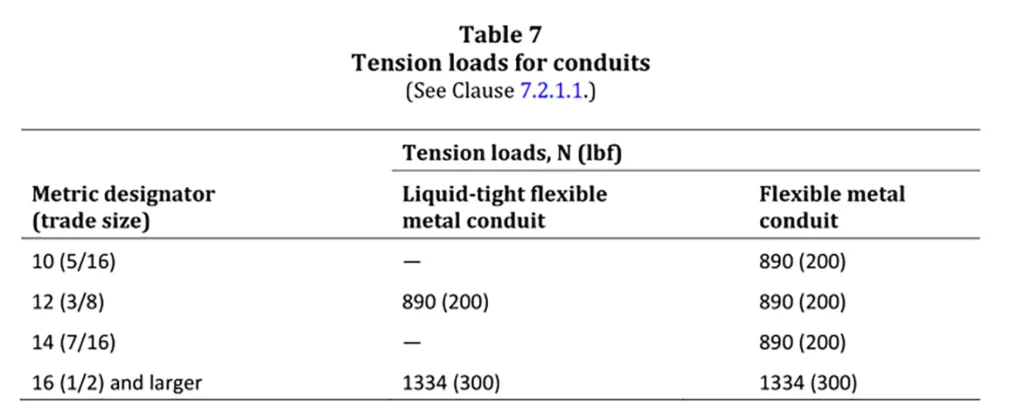
El FMC terminado debe soportar una carga de tensión axial (como se indica en la tabla CSA) durante un tiempo específico sin abrir sus circunvoluciones ni sufrir daños. Esta prueba verifica que el conducto pueda soportar fuerzas de tracción durante la instalación o el funcionamiento, lo que garantiza la integridad mecánica y la protección del cableado protegido.
Pruebas de flexibilidad
Los FMC deben mantener su integridad mecánica sin abrir sus circunvoluciones al doblarse alrededor de un mandril específico. Esta prueba garantiza que el conducto pueda soportar curvas cerradas en instalaciones reales sin comprometer su estructura ni su seguridad. La prueba sigue el protocolo de flexibilidad de cables blindados y cables con revestimiento metálico descrito en la norma CSA C22.2 n.º 2556.
Rendimiento del recubrimiento protector de zinc
El recubrimiento protector de zinc galvanizado aplicado a la banda de acero (utilizado en la fabricación de FMC) debe superar la prueba de resistencia a la corrosión mediante la prueba de sulfato de cobre (prueba Preece). La norma especifica que no se forman depósitos de cobre fijos después de los ciclos de inmersión, lo que garantiza la durabilidad del conducto en entornos hostiles o corrosivos.
Prueba adicional para conductos metálicos flexibles herméticos (LFMC)
El LFMC se somete a un conjunto de pruebas más exhaustivo debido a sus componentes adicionales (como una cubierta exterior termoplástica) y a su uso previsto en condiciones de humedad, corrosión o intemperie. Las pruebas pertinentes cumplen con la norma CSA C22.2 n.º 56 y hacen referencia a la norma CSA C22.2 n.º 2556.
1. Propiedades físicas de la cubierta termoplástica
El material de la cubierta debe cumplir con estándares específicos de resistencia a la tracción y elongación, tanto antes como después del envejecimiento acelerado. Estos criterios de rendimiento físico se prueban mediante los métodos de la norma CSA C22.2 n.° 2556 (cláusula 4.2), lo que garantiza que la cubierta exterior conserve su flexibilidad y resistencia a lo largo del tiempo.
2. Resistencia a la deformación
Las camisas LFMC deben resistir la deformación bajo calor y presión. Al someterse a 121 °C con una carga de 2000 g durante 1 hora, el espesor de la camisa no debe disminuir en más de 351 TP3T. Esto simula escenarios reales de estrés térmico.
3. Prueba de resistencia a la intemperie opcional
Para los productos marcados como aptos para uso en exteriores, la chaqueta debe conservar su resistencia a la tracción y elongación después de 1000 horas de exposición al arco de xenón, simulando los efectos de los rayos UV y la intemperie a largo plazo.
4. Rendimiento de tensión axial
El LFMC terminado debe soportar la tensión axial especificada (según el tamaño comercial del conducto) durante 60 segundos sin dañar la camisa ni abrir las convoluciones metálicas. Esto garantiza su durabilidad durante el tendido o la instalación.
5. Resistencia a la corrosión del recubrimiento de zinc
Al igual que FMC, la tira de acero de LFMC (tanto antes como después del formado) debe cumplir con los estándares de recubrimiento protector bajo la Prueba de Sulfato de Cobre, verificando la efectividad de la capa de zinc para resistir la corrosión.
6. Flexibilidad en condiciones de frío
El LFMC debe conservar su integridad estructural al someterse a doblado en frío. El conducto se acondiciona a una temperatura baja especificada y luego se dobla alrededor de un mandril en ambas direcciones. No deben producirse grietas ni separaciones ni en los componentes metálicos ni en los plásticos. Esta prueba de doblado en frío evalúa el rendimiento real en instalaciones a baja temperatura.
7. Resistencia al fuego
LFMC debe pasar pruebas de resistencia a las llamas:
Prueba de llama vertical FT1: El conducto debe autoextinguirse en un minuto tras cinco aplicaciones de llama de 15 segundos. No se puede quemar más de 25% de un indicador de marcado.
Prueba de llama de bandeja vertical FT4 opcional: Cuando corresponda, el conducto de una bandeja portacables (sin relleno) no debe exceder 1,5 metros de longitud de carbón. Esta prueba proporciona una garantía adicional para instalaciones donde la resistencia a la propagación del fuego es crucial.
8. Resistencia al impacto en frío
Después del acondicionamiento a temperaturas frías (según la Tabla 9 de la norma), el LFMC se somete a un impacto de 40 N. El conducto no debe agrietarse ni romperse, lo que demuestra robustez ante un posible abuso de campo durante condiciones de congelación.
¿Qué son los tubos eléctricos no metálicos (ENT)?
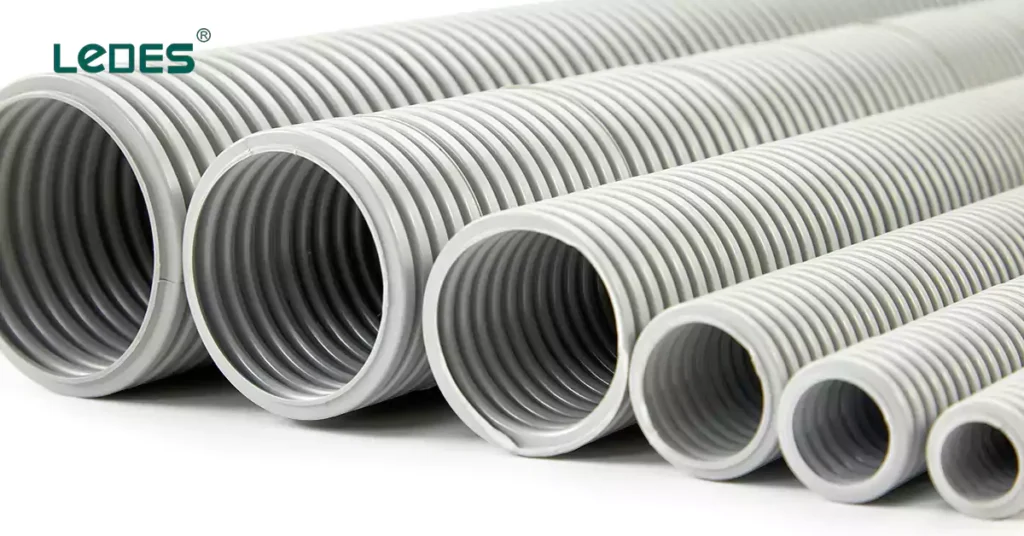
Tubos eléctricos no metálicos (ENT) es un sistema de canalización de plástico corrugado, flexible y ligero, diseñado para instalaciones de cableado eléctrico en edificios residenciales, comerciales e institucionales. Sirve como canal de protección para conductores y cables eléctricos, ofreciendo una alternativa eficiente a los sistemas tradicionales de conductos rígidos o metálicos.
ENT se fabrica con materiales no metálicos, generalmente cloruro de polivinilo (PVC) u otros compuestos termoplásticos, que ofrecen una combinación única de durabilidad, flexibilidad y resistencia a la corrosión. Su diseño corrugado permite doblarlo fácilmente sin necesidad de herramientas ni accesorios adicionales, lo que reduce el tiempo de instalación y los costos de mano de obra.
4 Características del conducto ENT
- Construcción flexible: La estructura corrugada de ENT permite un fácil paso a través de paredes, pisos y techos, incluso en espacios reducidos o complejos, sin codos ni equipos para doblar.
- Ligero: Significativamente más liviano que el conducto de metal, el ENT es más fácil de manipular, transportar e instalar.
- Material no metálico: Resistente a la corrosión, al óxido y a la degradación química, lo que lo hace adecuado para ambientes húmedos o corrosivos.
- Retardante de llama: ENT está diseñado para cumplir con los requisitos de rendimiento de llama y humo verticales según las normas de seguridad pertinentes de América del Norte.
5 ventajas del conducto ORL
- Instalación rápida y sencilla: ENT se puede cortar con una herramienta manual e instalar sin necesidad de equipos especiales para doblar o roscar, lo que reduce el tiempo de mano de obra y los costos.
- Reducción del manejo de materiales: Su peso ligero hace que sea más fácil de transportar y maniobrar en lugares de trabajo.
- Menor costo: Compared to metal conduit systems, ENT offers lower material and installation costs.
- Corrosion and Moisture Resistance: Ideal for damp or corrosive environments where metal conduits may degrade over time.
- Code Compliant: ENT is approved by both U.S. and Canadian standards (e.g., UL 1653 and CSA C22.2 No. 227.1) and is recognized in the National Electrical Code (NEC) and Canadian Electrical Code (CEC).
Codes and Standards for ENT Conduit
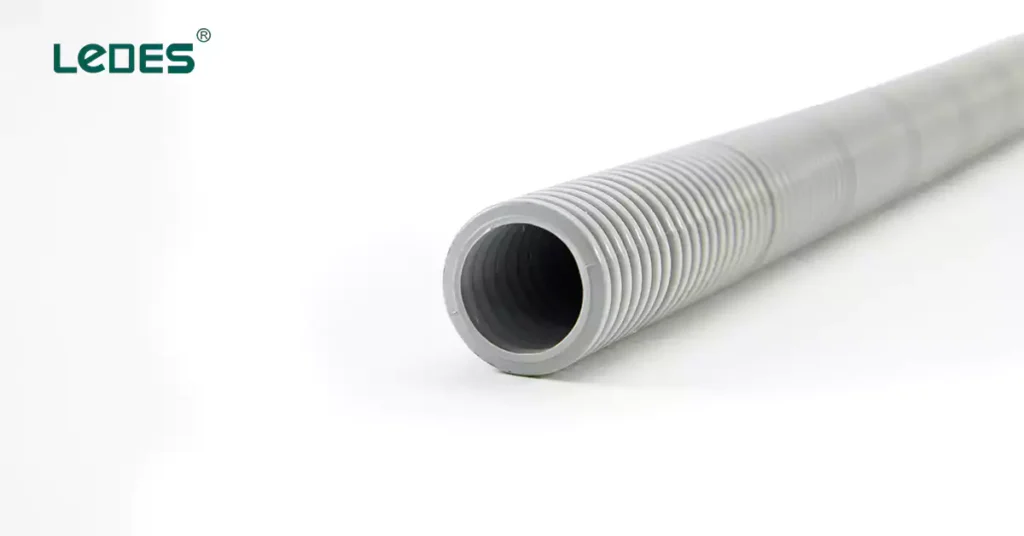
To ensure safe and compliance of ENT for electrical systems, ENT should comply to related industry standards and codes,
ENT Conduit Codes and Standards List
- Código Eléctrico Nacional (NEC) – Article 362 (ENT)
- Código Eléctrico Canadiense (CEC) – Section 12-1500 to 12-1514 (ENT)
- UL 1653 / CSA C22.2 No.227.1 – Safety Standard for Electrical Nonmetallic Tubing
NEC Article 362 - Electrical Nonmetallic Tubing (ENT)
NEC Article 362 covers the requirements for ENT, a pliable, corrugated, nonmetallic raceway used for electrical installations. According to Section 362.1, this article outlines the use, installation, and construction specifications for ENT and associated fittings. Importantly, Section 362.6 mandates that ENT and its fittings must be listed, ensuring they meet recognized safety and performance standards.
Usos permitidos
ENT is permitted in various applications, provided specific conditions are met:
- Building Height Restrictions: In buildings not exceeding three floors above grade, ENT can be used for exposed or concealed work, as long as it’s not prohibited by Section 362.12.
- Concealed Installations: In any building, regardless of height, ENT is allowed when concealed within walls, floors, and ceilings that provide a thermal barrier with at least a 15-minute finish rating.
- Fire Protection Exception: If an approved automatic fire protective system is installed on all floors, ENT may be used exposed or concealed in buildings exceeding three floors above grade.
- Concrete Encasement: ENT can be encased in poured concrete or embedded in a concrete slab on grade, provided fittings identified for this purpose are used.
- Ubicaciones húmedas: ENT is permitted in wet locations when installed in concrete slabs on or below grade, using fittings listed for the purpose.
- Consideraciones de temperatura: Conductors or cables rated at a temperature higher than the listed temperature rating of ENT may be installed, provided they are not operated at a temperature exceeding the ENT’s rating.
Usos no permitidos
ENT is not suitable for certain environments and applications:
- Ubicaciones peligrosas: ENT is prohibited in hazardous (classified) locations unless permitted by other NEC articles.
- Support of Equipment: ENT cannot be used to support luminaires or other equipment.
- High Ambient Temperatures: ENT should not be used where ambient temperatures exceed 50°C (122°F) unless listed otherwise.
- Direct Earth Burial: ENT is not permitted for direct burial in the earth.
- Exposed Locations: ENT is generally not allowed in exposed locations, with specific exceptions outlined in Section 362.10.
- Theaters and Similar Locations: ENT is restricted in theaters and similar venues, except as provided in Sections 518.4 and 520.5.
- Sunlight Exposure: ENT must not be used where exposed to direct sunlight unless identified as sunlight resistant.
- Daño físico: ENT is unsuitable for areas where it would be subject to physical damage.
Requisitos de tamaño y relleno
- Minimum and Maximum Sizes: ENT trade sizes range from ½” (metric 16) to 2½” (metric 63)。
- Conductor Fill: The number of conductors or cables in ENT must comply with Chapter 9, Table 1 of the NEC for allowable percentage fill (362.22).
Construction Specifications
- Requisitos materiales: ENT must be made of material that does not exceed the ignitability, flammability, smoke generation, and toxicity characteristics of rigid (nonplasticized) polyvinyl chloride.
- Calificación: ENT must be clearly and durably marked at least every 3 meters (10 feet) as required in Section 110.21(A). The type of material should also be included in the marking.
CEC Requirements for ENT Conduit
In Canada, the use and installation of Electrical Nonmetallic Tubing (ENT) is regulated under Section 12 of the Canadian Electrical Code (CEC), Part I, specifically Rules 12-1500 to 12-1514. These requirements govern permitted uses, restrictions, installation practices, and safety provisions.
Permitted Uses
ENT is permitted in the following conditions, subject to compliance with general wiring rules:
Instalaciones Subterráneas:
ENT may be used underground, including burial depth, mechanical protection, and backfilling.
Exposed or Concealed Locations:
ENT is suitable for both exposed and concealed installations within buildings, provided other CEC provisions are met.
Restrictions on Use
ENT shall not be used in locations where it may be subject to physical damage, unless adequate mechanical protection is provided. This includes areas susceptible to impact during or after construction.
Soportes
ENT must be securely fastened in place using approved methods:
Support must be placed within 1 meter of each outlet box, junction box, cabinet, coupling, or fitting.
The maximum spacing between supports is 1 meter.
Número de conductores
The conductor fill capacity inside ENT must comply with Rule 12-910, which specifies allowable conductor quantities based on cross-sectional area and conductor insulation types. Overfilling the conduit can lead to overheating and noncompliance with ampacity derating rules.
Temperature Limitations
ENT has temperature-based installation limitations:
- ENT must not be used in areas where the tubing may be exposed to temperatures exceeding 75°C under normal operating conditions.
- Higher-temperature rated insulated conductors (above 75°C) may be used, but ampacity must be limited to that of 90°C rated conductors, regardless of the conductor’s rating.
Connections and Couplings
Above-ground Joints:
When ENT is joined or connected to fittings, boxes, or cabinets, only fittings specifically designed for ENT are permitted.
Underground Joints:
When used underground, ENT couplings must be solvent-cemented using a suitable cement to ensure moisture resistance and mechanical strength.
Support of Equipment
ENT is not permitted to support electrical equipment such as luminaires, boxes, or cabinets. All equipment must be supported independently to avoid structural stress on the tubing.
Bonding Continuity
ENT is a non-conductive raceway, and therefore, a separate bonding (grounding) conductor must be installed in accordance with Rules to ensure electrical continuity and fault current return path.
UL1653 / CSA C22.2 No.227.1 - Standards for ENT
Electrical Nonmetallic Tubing (ENT) is manufactured to meet rigorous safety, mechanical, and material performance requirements under UL 1653 and CSA C22.2 No. 227.1. These harmonized North American standards ensure that ENT products are safe for use in building wiring systems across the U.S. and Canada.
Construction and Material Requirements
Non-metallic and corrugated, allowing for flexibility during installation.
Made from thermoplastic materials such as PVC or polypropylene, formulated to meet flame resistance, mechanical strength, and temperature performance requirements.
ENT is used in a ambient temperature of 50°C, if used in attics, it should have a relative thermal index of 60°C.
Dimensiones
Here’s a brief overview of the most critical performance tests required by UL1653 / CSA C22.2 No.227.1:
Vertical Flame Test
Assesses ENT’s flame-retardant capability. The tubing must self-extinguish and limit flame spread when subjected to a vertical burn test.
Bending Test
Ensures the tubing retains structural integrity and does not crack when bent to a specified radius at room temperature.
Prueba de deflexión
Measures deformation under applied load. ENT must resist excessive flattening when pressure is applied.
Impact Test
Verifies toughness by dropping a weight onto the tubing at both room and cold temperatures. ENT must not crack or shatter.
Cold Bend Test
Conducted at low temperatures (typically -20°C), this test checks for brittleness. ENT must remain flexible and unbroken.
Prueba de tensión
Ensures that fittings and conduit connections resist pullout forces typical in installation conditions.
Prueba de rigidez
Evaluates mechanical rigidity to prevent sagging or collapse during installation and operation. In Canada, the ENT should have a minimum stiffness of 300 kPa at 5% deflection. In the U.S. there’s no requirement specified.
For detailed descriptions, pass criteria, and test procedures, please refer to our article: ENT Tubing for code compliance and test items.
FMC vs. ENT: A Comprehensive Comparison
Choosing the right type of conduit, Flexible Metal Conduit (FMC) or Electrical Nonmetallic Tubing (ENT), depending on several key factors including application environment, mechanical protection requirements, code compliance, ease of installation, and cost.
Both FMC and ENT serve similar functions in protecting and routing electrical wiring, but their materials, construction, and performance characteristics differ significantly. Understanding these differences is essential to selecting the most suitable solution for your specific project.
The following comparison table outlines the critical distinctions between FMC and ENT in terms of materials, flexibility, environmental resistance, fire performance, strength, installation needs, and typical applications.
Característica | FMC | Otorrinolaringología |
Material | Acero galvanizado o aluminio | CLORURO DE POLIVINILO |
Flexibilidad | High; bends easily, but requires more effort than ENT | Very high; easily bends by hand without tools |
Resistencia a la corrosión | Moderate; better with coated FMC or aluminum | Excellent; inherently non-corrosive |
Mechanical Protection | Superior; provides robust protection against physical damage | Limited; needs extra protection if exposed to damage |
Fire Performance | Inherently fire-resistant (high melting point, non-combustible) | Fire resistant, flame retardant, self-extinguishing (moderate) |
Instalación | Relatively easy; requires cutting tools (hacksaw/grinder) and sometimes benders | Easier; hand-bendable, simple cutting tools, snap-on fittings |
Bonding/Grounding | Metal body can serve as ground if listed | Requires separate bonding conductor |
Peso | Más pesado | Ligero |
Costo | Higher material and labor cost | More cost-effective |
Codes and Standards | NEC, ECE, UL 1, CSA C22.2 No.56 | NEC, CEC, UL 1653, CSA C22.2 No.227.1 |
Aplicaciones comunes | Dry locations, motor leads, vibration-prone areas | Concrete slabs, walls, ceilings, residential and commercial wiring |
FMC or ENT: Making the Right Choice for Your Project
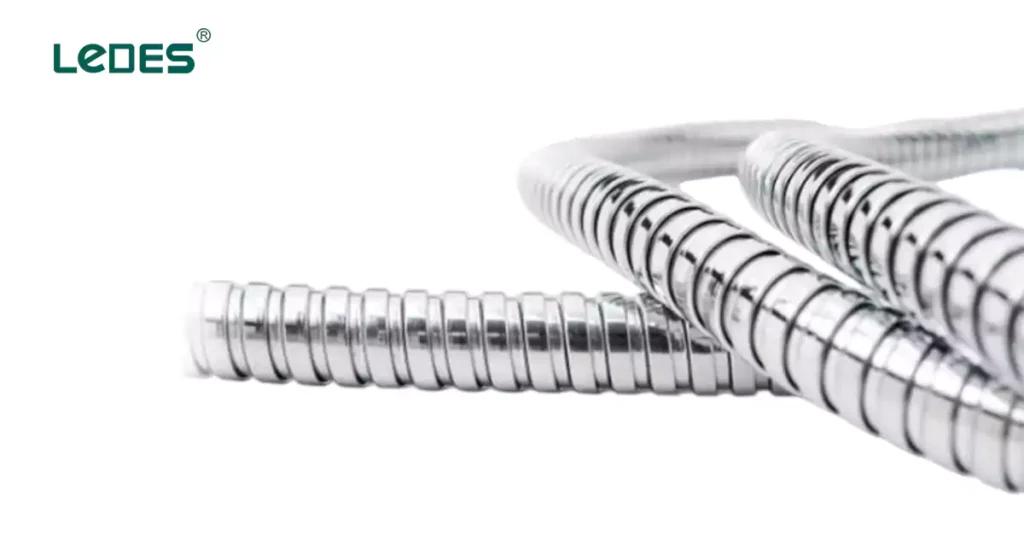
When selecting between Flexible Metal Conduit (FMC) and Electrical Nonmetallic Tubing (ENT), it’s essential to go beyond just code compliance. The right choice depends on a careful balance of site-specific conditions, installation goals, performance needs, and future adaptability.
1. Environmental Conditions
- Wet or dry locations: The installation environment is the first and most decisive factor. In dry, interior locations, both FMC and ENT are viable options. However, when dealing with wet, damp, or outdoor conditions, standard FMC is not suitable—Liquidtight Flexible Metal Conduit (LFMC) is required in such cases. ENT, while moisture-resistant, typically cannot be used in direct burial or continuously wet outdoor environments, unless specially rated.
- Exposed and concealed: Concealment and exposure also matter. FMC is permitted in both exposed and concealed areas. ENT, by contrast, must be concealed in buildings taller than three stories, per NEC requirements, and may only be used in exposed areas of smaller buildings if not subject to physical damage.
- Temperature and Chemical: Temperature and chemical exposure are further considerations. FMC, with its metallic construction, withstands temperature extremes and harsh environments better. ENT, made from PVC, can degrade above 50°C unless listed otherwise and may deform under sustained heat loads, but still offers good chemical resistance for many indoor applications.
2. Mechanical Protection
- Mechanical Durability: When it comes to mechanical durability, FMC has a clear advantage. Its metal construction makes it well-suited for areas with risk of impact, vibration, or abrasion, such as commercial kitchens, industrial facilities, or locations near machinery. ENT is more flexible but offers limited protection, making it ideal for concealed runs in residential or commercial walls where physical threats are minimal.
- Vibration: Vibration resistance is another critical area where FMC excels. Its helical structure helps absorb movement, making it ideal for connections to motors and vibrating equipment.
- EMI Shielding: Additionally, FMC provides electromagnetic interference (EMI) shielding, a key requirement in applications involving sensitive electronics or data communication systems. ENT, being non-metallic, offers no such protection.
3. Cost, Labor, and Maintenance
Cost evaluations must go beyond just the price of conduit per foot. ENT offers faster installations, with snap-in fittings and hand-bendability reducing labor time dramatically. It’s particularly effective in high-volume or repetitive applications like residential or office construction, where labor savings can outweigh material costs.
On the other hand, FMC’s higher material and labor costs reflect its robustness. For environments that demand greater resilience and fire resistance, the additional investment often pays off in reduced risk and lower long-term maintenance.
Maintenance needs also diverge: ENT is corrosion-proof and largely maintenance-free. FMC is corrosion-resistant but may require inspection and possible replacement over time in corrosive or damp environments.
4. Understand the Code
Regardless of material performance, all installations must meet the National Electrical Code (NEC) and any local amendments. For example:
ENT is not permitted in plenum spaces or hazardous environments.
FMC must meet bonding and grounding requirements, particularly in power distribution applications.
Engaging early with the Authority Having Jurisdiction (AHJ) ensures that material choices will pass inspection and that any special-use conditions are accounted for. Some inspectors may scrutinize markings or listings more closely than others, so proactive planning pays off.
5. Plan for the Future
In a world where system modifications and technology upgrades are frequent, future-proofing conduit infrastructure is a smart move. ENT’s flexibility and pull-through design make it easier to add or re-route wiring, minimizing downtime during upgrades. This makes it a strong contender for tenant spaces, education, or healthcare facilities, where adaptability is key.
FMC, while less flexible once installed, still supports cable changes and upgrades—especially if installed with accessible junction points.
5 Common Installation Mistakes and Best Practices
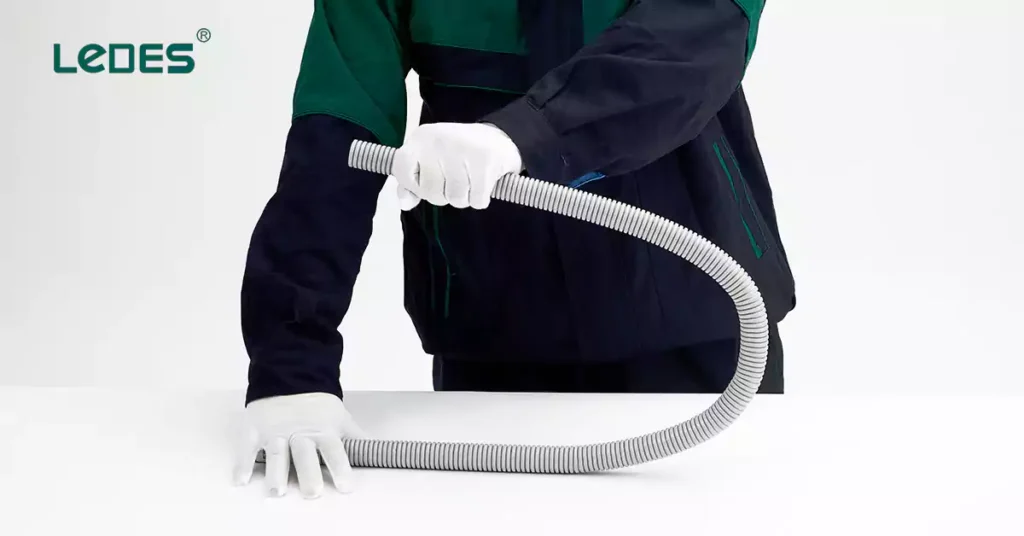
Whether working with Flexible Metal Conduit (FMC) or Electrical Nonmetallic Tubing (ENT), proper installation is essential for electrical safety and long-term system performance. Despite their differences in material and flexibility, both conduit types are vulnerable to common installation mistakes. Below, we explore these pitfalls and outline best practices that ensure code compliance, reliability, and efficiency.
Consejos profesionales: ¿Quieres saber más sobre? conduit fill, cutting ENT, and pull wiring tips for ENT conduit? You can click the link above to read our previous article.
1. Avoiding Incorrect Sizing and Overfilling
- Choosing the right size: Selecting the correct conduit size is more than a matter of convenience, it’s a critical safety consideration. Undersized conduits restrict airflow around conductors, increasing the risk of overheating and making wire pulling labor-intensive. On the other hand, unnecessarily large conduit may increase project costs and complicate fittings and support systems.
- Fill Capacity: Another frequent issue is overfilling, where too many wires are packed into the conduit. This not only makes installation harder but also poses a real fire hazard due to reduced heat dissipation. Best practice dictates always referring to NEC fill tables to determine proper sizing based on conductor count and gauge. For general guidance, keeping conduit fill below 40% for multi-wire installations strikes a balance between safety, ease of maintenance, and future upgrades.
2. Proper Support and Secure
FMC and ENT, though flexible, require structured support. Without it, conduits can sag, shift, or even become damaged, putting both the conduit and internal wiring at risk. Secure anchoring at proper intervals maintains alignment, reduces mechanical stress, and preserves system integrity over time.
The National Electrical Code provides clear guidelines for support spacing. FMC typically must be supported every 4.5 feet and within 12 inches of termination points. ENT requires tighter control – support every 3 feet and near ends. Using appropriate clamps, straps, or hangers matched to the conduit material is crucial to prevent loosening, movement, or abrasion in active environments.
Support according to you local codes.
3. Bending Limits
Both FMC and ENT are valued for their flexibility, but that doesn’t mean bending them is without limits. Improper bending—such as tight corners or excessive cumulative angles—can lead to pinched conductors, insulation breakdown, and increased pulling resistance. These issues often translate into costly delays or failures down the line.
To avoid these outcomes, installers should respect the minimum bend radius, typically no less than three times the conduit diameter, and limit total bend angles in a single run to 360 degrees. FMC usually requires a mechanical bender for clean, consistent bends, while ENT can be bent manually, though still with care and control. The goal is smooth, gradual curves that support wire movement without stressing materials.
4. Addressing Environmental Factors
Conduit failure often stems from installing products in environments they weren’t designed to withstand. For example, using standard FMC in damp or wet areas can accelerate corrosion, while exposing ENT to direct sunlight or underground conditions without proper ratings may lead to cracking or deformation.
A key best practice is aligning conduit type with site conditions from the start. For wet locations or outdoor use, Liquid-tight FMC is the proper choice due to its sealed jacket. Standard ENT performs best indoors or within concrete slabs, where it’s protected from UV rays and water. Installers should also be mindful of ambient temperature ranges and ensure all fittings are adequately sealed to prevent moisture ingress.
5. Ensuring Proper Connections and Grounding
Even with the right conduit and layout, poor connections can undermine the entire system. Loose fittings can expose wires, interrupt continuity, or introduce vibration damage. For metallic conduit like FMC, grounding is especially critical to prevent shock hazards and meet code requirements.
All fittings should be listed and compatible with the conduit material, and connections must be tightened thoroughly. For FMC, continuity must be maintained across joints, and proper bonding techniques used to meet NEC Article 250 standards. ENT, being non-metallic, does not conduct electricity, so any required equipment grounding must be handled by running a separate ground conductor within the tubing.
Conclusión
Flexible Metal Conduit (FMC) and Electrical Nonmetallic Tubing (ENT) are essential components in modern electrical systems, each offering unique advantages for specific applications. FMC provides rugged protection with grounding capabilities, making it ideal for areas where mechanical strength and EMI shielding are required. ENT, on the other hand, excels in lightweight, easy-to-install scenarios such as residential or concrete-encased runs.
However, the benefits of these conduit systems can only be fully realized through proper product selection, installation, and adherence to code requirements. Missteps, such as improper sizing, inadequate support, poor bending practices, or misapplication in unsuitable environments can compromise not only the functionality of the system but also safety and code compliance.
By understanding their characteristics, following local guidelines, and applying best practices in the field, installers can ensure that both FMC and ENT deliver long-term performance, durability, and safety. Whether in new construction or retrofit projects, investing in quality materials and precision workmanship pays off in reduced maintenance, greater electrical reliability, and peace of mind.
As electrical infrastructure continues to evolve, particularly with the expansion of energy-efficient and smart systems, knowing when and how to use FMC and ENT will remain a crucial skill for electricians, engineers, and project managers alike.
Preguntas frecuentes
What is FMC conduit?
FMC stands for Flexible Metal Conduit. It is a type of electrical conduit made of a helically wound metal strip, providing flexibility for routing electrical wiring in tight or complex spaces. FMC is commonly used in commercial and industrial settings where vibration or movement may occur, or where conduit needs to navigate around obstacles.
How to cut FMC conduit?
To cut FMC conduit, follow these steps:
- Measure and mark the desired length using a measuring tape and marker.
- Use a rotary tool (like a hacksaw or specialized FMC cutter) to cut along the marked line.
- Deburr the cut ends using a reaming tool or pliers to remove sharp edges.
- Insert an appropriate connector to ensure a secure and code-compliant installation.
Can FMC be used as a ground?
Yes, FMC can serve as an equipment grounding conductor (EGC) if it meets the conditions outlined in NEC Article 250.118(5). Specifically:
The FMC must be continuous and securely fastened.
It must have appropriate fittings listed for grounding.
The total length and conductor size must comply with the NEC grounding provisions.
What is ENT conduit?
ENT (Electrical Nonmetallic Tubing) is a flexible, non-metallic raceway made from PVC. It is lightweight, flame-resistant, and designed for easy installation in walls, floors, and ceilings. ENT is used primarily in indoor residential and commercial applications.
When to use ENT conduit?
Use ENT conduit when:
Flexibility is needed for bends without fittings.
The installation is in dry, indoor locations, such as within walls or poured concrete.
Non-metallic, corrosion-resistant properties are desired.
A lightweight, labor-saving alternative to EMT or PVC is preferred.
Can ENT conduit be used outdoors?
Generally, no. ENT is often used within walls, floors, ceilings, or concrete encased. But it can be used outdoors if have UV inhibitors and approved by the manufacturer and code, but make sure it won’t exposed to direct sunlight for a long time or mechanical damage.
Is ENT conduit waterproof?
No, ENT is not waterproof. It is moisture-resistant, but it is generally recommended for dry locations and not designed to be submerged or exposed directly to water. For wet or damp locations, PVC or Liquid-tight Flexible Conduit (LFMC) should be used instead.
Is ENT conduit plenum rated?
No, ENT is not plenum rated unless it is:
Specifically tested and listed for use in plenum spaces.
Installed according to manufacturer guidelines and local fire codes.
In general, use metallic conduit or plenum-rated alternatives in air-handling spaces.


